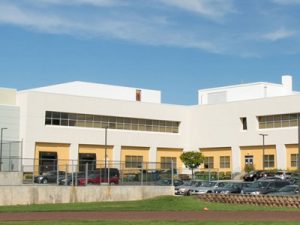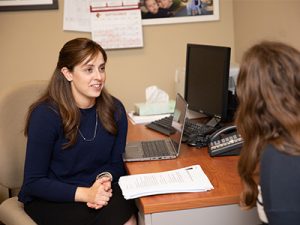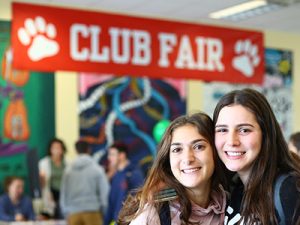Spotlight on the Math Department: Promoting Student-Centered Learning
November 27, 2017
 By Sabrina Bernath, Math Department Chair
By Sabrina Bernath, Math Department Chair
What does your average math class look like at Frisch? Well, you might be hard-pressed to come up with a typical example. With over 36 different math classes being taught every day, no two are exactly alike. Yet one thing they all have in common is a curriculum-driven, student-focused mode of instruction.
One of the ways math teachers at Frisch reinforce key concepts is through the thoughtful use of technology, for the purpose of empowering students in their learning. For example, in one ninth grade Geometry class, the teacher used a Kahoot game to help students learn about complementary and supplementary angles. Kahoot actively engaged every student in a game show-like competition, with no student passively sitting out of the lesson. Seeing how much the students enjoyed actively learning through this technological tool, the teacher then created a SMART Board presentation where students themselves – rather than the teacher – “cloned” images on the SMART Board to piece together the angles formed by two parallel lines cut by a transversal. The hands-on manipulation of the geometric shapes helped the students learn which of the angles were congruent. Since neither of these lessons was taught by frontal instruction, the two exercises gave the teacher real-time insight into how much the students understood. She did not have to wait until she collected homework or corrected their tests; both she and her students knew right then and there what their level of understanding was, and had the opportunity to work on learning the material with the help of their peers.
 Another method of integrating technology in the classroom was successfully executed by a different teacher, in her Algebra 2 and Calculus classes. Using pre-created Desmos classroom activities, students explored new concepts using the dynamic graphing software, worked through a series of questions on their computers, and received teacher feedback and input from their classmates. In Algebra 2, students developed the distance interpretation of absolute value inequalities and made connections between inequalities, verbal statements, number line graphs, and solution sets. This is an important skill for their high school math studies, and also crucial for further studies in any science field. Meanwhile, in Calculus class, students used a series of dynamic graphs to explore one-sided limits. They were then reminded of the definition of continuity and were asked a series of questions to assess their understanding of the definition. They could use the software to help develop their answers and get additional assistance from their classmates. With immediate feedback and real-time manipulation of the various equations and their respective graphs, the students quickly acquired a more nuanced and deeper understanding of the various factors at play in a graph. They also got teacher feedback and input from their classmates.
Another method of integrating technology in the classroom was successfully executed by a different teacher, in her Algebra 2 and Calculus classes. Using pre-created Desmos classroom activities, students explored new concepts using the dynamic graphing software, worked through a series of questions on their computers, and received teacher feedback and input from their classmates. In Algebra 2, students developed the distance interpretation of absolute value inequalities and made connections between inequalities, verbal statements, number line graphs, and solution sets. This is an important skill for their high school math studies, and also crucial for further studies in any science field. Meanwhile, in Calculus class, students used a series of dynamic graphs to explore one-sided limits. They were then reminded of the definition of continuity and were asked a series of questions to assess their understanding of the definition. They could use the software to help develop their answers and get additional assistance from their classmates. With immediate feedback and real-time manipulation of the various equations and their respective graphs, the students quickly acquired a more nuanced and deeper understanding of the various factors at play in a graph. They also got teacher feedback and input from their classmates.
Flipped learning is another wonderful way to create student-centered learning. In several Algebra 2 classes, teachers used Playposit videos to introduce the ideas of matrices. Playposit is a program which allows users to embed questions, polls, and reflective pauses into videos which they can then share with others. Watching the introductory Playposit videos at their leisure the night before the lesson allowed the students to learn the difficult concept of matrices at their own pace. The embedded questions forced them to reflect on the material being presented and also gave them the chance to replay parts of the video again if needed. Both teachers, who have taught Algebra 2 for years, marveled at how quickly all the students were able to show mastery of the skills the next day.
The Frisch Math Department looks forward to the remainder of the year. There is much to teach, and our faculty will continue to work on progressive and engaging modes of instruction with a goal of keeping the learning in the hands of the students!







 Another method of integrating technology in the classroom was successfully executed by a different teacher, in her Algebra 2 and Calculus classes. Using pre-created
Another method of integrating technology in the classroom was successfully executed by a different teacher, in her Algebra 2 and Calculus classes. Using pre-created